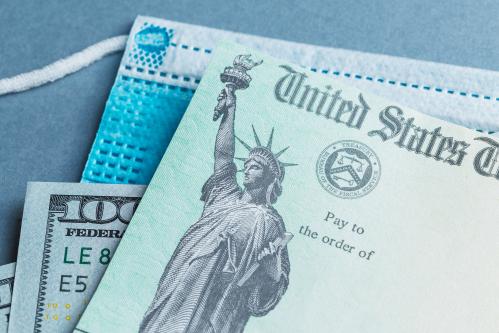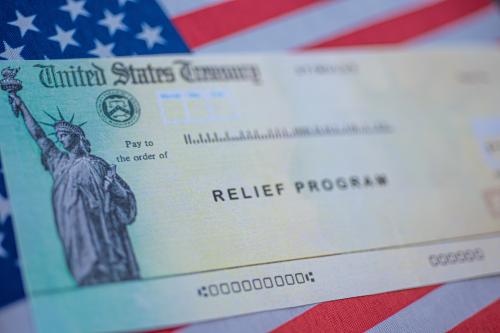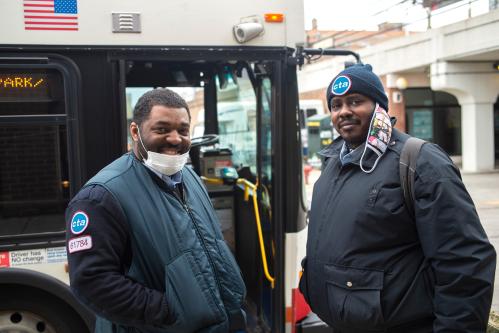As the nation begins to grapple with the shape of its post-COVID-19 economy, policymakers are exploring how to better (if belatedly) support the millions of low-wage, essential workers that kept the country functioning during the pandemic.
In March, our colleagues Molly Kinder and Laura Stateler laid out an impressive agenda for paying, protecting, and empowering low-wage, essential workers, including suggestions on how to boost worker pay and income stability. To these urgent needs, we’d add one more policy consideration: massively expanding retirement savings for low-wage workers.
A significant share of American workers lacks access to retirement savings. And, like many other economic trends in the U.S., access to retirement benefits hinges largely on income. While 90% of the highest-paid workers have access to an employer-sponsored retirement plan, just 30% of the lowest-paid workers do.
 Additional divides exist as well, with part-time workers, nonunion workers, and workers at smaller companies all having less access to employer-sponsored retirement plans. In short, as low-wage service work continues to proliferate across the country, millions of workers lack access to a benefit once seen as standard for the middle class: the promise of a financially secure retirement. Action to establish that benefit for all is necessary.
Additional divides exist as well, with part-time workers, nonunion workers, and workers at smaller companies all having less access to employer-sponsored retirement plans. In short, as low-wage service work continues to proliferate across the country, millions of workers lack access to a benefit once seen as standard for the middle class: the promise of a financially secure retirement. Action to establish that benefit for all is necessary.
Back in 2017, Brookings Metro wrote about how the Trump administration and congressional Republicans had stymied progress on developing a common-sense solution to the nation’s retirement crisis: the automatic individual retirement account (auto-IRA). As noted then, this effective, nonpartisan policy was developed by researchers J. Mark Iwry of Brookings and David C. John of the Heritage Foundation to help low-wage workers without access to an employer-sponsored plan save for retirement. Today, the idea’s relevance has only grown.
How does an auto-IRA work? When a worker is hired in a state with such a program, if their employer does not offer a retirement plan, they are automatically enrolled in a defined-contribution IRA sponsored by the state and managed by a professional financial services company. Evidence shows that “automatic” enrollment in benefits such as retirement plans encourages higher participation by workers, with particularly large participation gains among young, low-income, and minority workers. The default contribution is typically 5% of a worker’s paycheck. And because the plan is structured as an IRA, it is portable—meaning employees can keep their retirement plan even if they change employers.
Given these selling points, congressional Republicans’ attempt to sabotage promising state and local progress on enacting auto-IRAs in 2017 was discouraging. Specifically, they used a somewhat obscure law known as the Congressional Review Act to repeal an Obama administration regulation that laid out guidance for states to establish auto-IRAs without running afoul of the Employee Retirement Income Security Act (ERISA). Without this so-called “safe harbor” regulation, cities’ and states’ newly established auto-IRAs were left open to legal challenges.
So far, the sabotage effort has failed. Despite the risk of lawsuits, nine states and the city of Seattle had passed legislation creating an auto-IRA program as of the end of 2020, and several other states had introduced legislation. And these plans seem to be working: In Oregon, where all companies with five or more employees are now participating in the state’s OregonSaves auto-IRA, early estimates showed that over 70% of workers chose to remained enrolled in their IRA plan. In other states, between 65% and 70% of workers have chosen to remain enrolled.
But without safe harbor protection, these plans have been the targets of lawsuits—most notably, California’s CalSavers program. However, courts to date have ruled in favor of CalSavers, and the Biden administration recently announced that the federal government would no longer support the lawsuit seeking to end the program.
Now that the model has been proven, more states should adopt auto-IRAs. And, spurred on by California’s legal victories and the Biden administration taking office, several are. In late February, Virginia passed legislation to establish a state auto-IRA, and even deep-red Oklahoma is exploring the creation of one.
Auto-IRAs are becoming less partisan, and the federal government has a strong incentive to encourage them. However, there’s no guarantee that state auto-IRAs will continue to win in court. An adverse legal ruling or a future presidential administration that is more hostile to auto-IRAs could impede this progress.
With a current presidential administration that has explicitly committed to improving worker welfare and endorsed automatic retirement benefits enrollment through its Unity Task Force, now is the moment for Congress to expand retirement security. To permanently end the threat of legal challenges and give more states the confidence to move forward, the federal government should take steps to legalize auto-IRAs nationwide.
One option would be a single, national automatic IRA act. In recent years, the concept of automatic enrollment has become something of a bipartisan issue, with Rep. Richard Neal (D-Mass.) and Rep. Kevin Brady (R-Texas) introducing the Securing a Strong Retirement Act last year, which would require all new employer-sponsored retirement plans to have automatic enrollment. The Automatic Retirement Plan Act, introduced by Rep. Neal in 2017, would go a step further and require that most employers offer their workers a retirement plan and make enrollment in those plans automatic. However, it’s not clear whether that act would be eligible for the filibuster-averting reconciliation process. If not, it may be a long shot in the Senate absent any sort of filibuster reform.
In the absence of a single national plan, Congress could instead support more cities and states enacting their own auto-IRAs. To provide permanent legal clarity, it would be helpful to re-establish the safe harbor created during the Obama administration. However, the Biden administration can’t do this on its own; once a regulation is overturned under the Congressional Review Act, the executive branch is forbidden from issuing a new rule that is “substantially in the same form” as the overturned rule unless specifically authorized by law. In other words, Congress needs to explicitly re-authorize it.
In addition to re-establishing safe harbor, Congress could provide federal funding to help cover the upfront costs for cities and states that choose to establish auto-IRA programs. This approach may be able to garner some bipartisan support as more purple and red states consider enacting state-run auto-IRAs, depoliticizing the issue on the state and local level.
Meanwhile, other income-boosting policies Congress is considering can make auto-IRAs more effective. For example, some workers opting out of state-run auto-IRAs may be low-wage workers with immediate financial needs who feel they do not have enough money to save for retirement. Income-boosting policies such as a minimum wage increase, an Earned Income Tax Credit expansion, or the recent expansion of the Child Tax Credit can give workers the extra income they need to contribute to their retirement. In this regard, income-boosting policies don’t just give workers more short-term spending power, but can also foster greater long-term economic security.
With the COVID-19 pandemic hopefully nearing its end, 2021’s job growth projections are optimistic. But as the U.S. has seen in recent years, job growth isn’t worth much if the jobs don’t have good pay or benefits. This is a unique moment to shore up the financial security of the millions of American workers without retirement savings. Congress must give cities and states the green light to help workers trapped on the wrong side of this fault line of American inequality.







Commentary
What’s stopping automatic retirement savings for more workers?
April 9, 2021